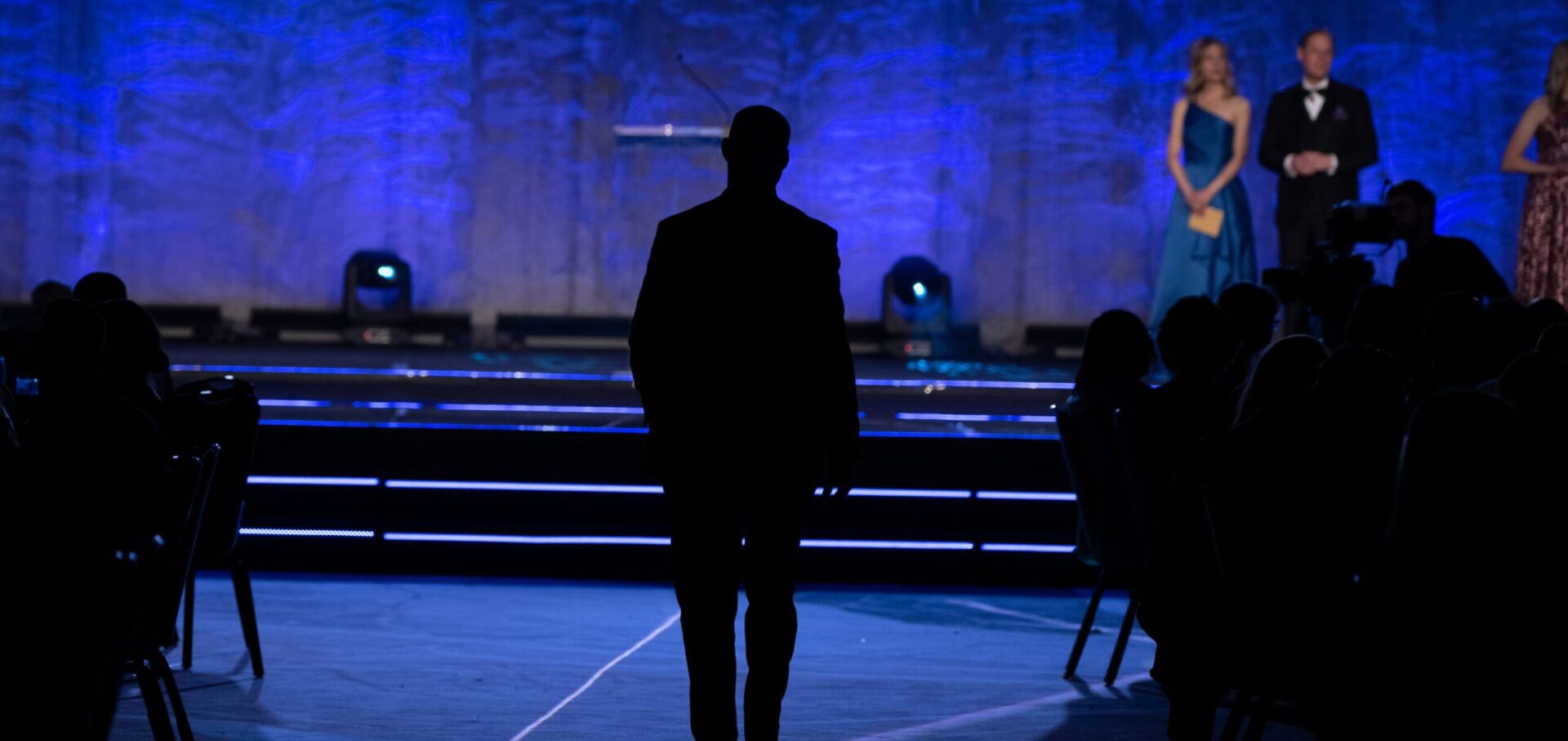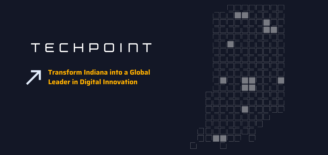Tactile Engineering wins Product Innovation of the Year Mira Award
Lafayette, Ind.-based Tactile Engineering, inventor of the Cadence electronic braille tablet, won the award for Product Innovation of the year during TechPoint’s 24th annual Mira Awards gala honoring the best of tech in Indiana.
Against a backdrop of nearly 30 years of consistent warnings that their concept was “impossible,” to achieve, the Tactile Engineering team proved the naysayers wrong last year with the launch of the Cadence tablet, a mass-produced, affordable, reliable and portable electronic braille and graphics display for the blind and visually impaired (B/VI) community.
Their determination, and their revolutionary product which promises to improve the lives of millions of B/VI people across the globe, earned them the 2023 TechPoint Mira Awards Product Innovation of the Year Award.
Until Cadence, millions of blind people, including tens of thousands of Hoosiers, lacked adequate access to braille and tactile graphics. That barrier to education directly contributed to literacy rates lower than 5 percent, college graduation rates that are one-half the graduation rate of the sighted population and an unemployment rate of more than 50 percent among the B/VI community.
The Cadence tablet brings educational tools for the B/VI community into the modern age, giving them many of the modern computer-based conveniences that sighted people take for granted and have had for decades.
The device provides an active tactile graphical display that replaces bulky paper braille and printed tactile graphics with a portable, modular device that serves as both a mobile interface and a desktop monitor. With it, blind individuals can create, edit and send graphics content online. Its display enables moving tactile graphics to change right under a user’s hands, opening an entirely new way for the blind to access information and content. Labels and callouts can appear, update, and disappear from a graph or diagram on demand. Data from scientific instruments can be collected, graphed, and analyzed in real time. Students and test-takers can easily switch between text, graphics and scratchpads.
The tablet also creates an entirely new medium for content and leisure. Users can play rich, complex video games, access enhanced e-books and streaming media, and view the action of a sports event in real time.
The device was piloted at the Indiana School for the Blind and Visually Impaired in preparation for full deployment to schools and organizations across Indiana this year. Response from students, educators, industry and government has been overwhelmingly positive, and the company has been inundated with contacts and requests from other states and countries seeking similarly scaled deployments for their own B/VI populations.
There’s good reason so many vendors and want-to-be supporters of Tactile’s concept said it was impossible to implement. A usable tactile display must be able to consistently display braille dots and graphics, using a “screen” of actuated dots, moving columns, or some other form of movable surface. Each full Cadence tablet has more than 1,000 independently operating actuators, all packed right next to each other, each required to function millions of times reliably and safely – all while being handled daily by a five-year-old or carried in a backpack to school.
The road to Cadence started in the 1990s at a Purdue University lab. The core Tactile team – Dave Schleppenbach, Tom Baker, Alex Moon, and Wunji Lau – combined their engineering, physics, chemistry, computer science, accessibility and education expertise to develop the tablet from the ground up with mass production, low cost and ease of maintenance as ironclad requirements. In 2013, Baker and Moon conceived and developed an entirely new technology, and Tactile Engineering was born. Since then, the team has developed the braille modules, modular tablets, and the firmware and operating system for the Cadence and partnered with several engineering and manufacturing firms, working with Indiana companies whenever possible.
The project required extensive research into precision micro-actuators that went beyond the experience of the team’s professors, consultants and manufacturing partners.
“We were told so many times that our specifications were impossible that we ended up having to do it ourselves, which is how our facility in Lafayette came to be,” the team said.
They designed the automated, high-precision manufacturing facility using off-the-shelf components predominantly sourced from Indiana vendors and manufacturers to produce the laptop. They also designed incredible precise equipment necessary to build the device, and its hundreds of components, including self-supporting copper wire coils with size, durability and consistency.
More than simply an array of electronic dots, the Cadence is a platform that runs apps downloaded from the Internet, just like a smartphone. The Cadence screen enables a blind user to “view” images, animated graphics and braille, opening up an entirely new way of reading and interacting with content. With Cadence:
- A blind math student can “see” and manipulate an entire equation at once,
- A science student can interact with a moving molecular structure,
- An office worker to adjust a line graph,
- Teachers can interact with blind students remotely, and
- Users can independently create tactile content and share it for collaborative graphical projects.
Other companies in the B/VI product space have produced prototype or short-run tactile displays, but only Tactile Engineering has solved the problem of affordable mass production. Existing commercial braille displays use bulky, expensive piezoelectric actuators that have been essentially unaltered since the 1980s. Other attempts have used microfluidics, stepper motors, and electrochemical reactions. Cadence leverages modern, off-the-shelf raw materials to keep costs low and ensure a sustainable logistics chain.
The Tactile team bootstrapped the project through many years of design and prototype stages. But in addition to their product launch success in 2022, they also secured $2 million in seed funding. Their first major deployment is scheduled for fall 2023 and is supported by state government with future funding allocations in the works.
Numerous companies and organizations have committed to purchase the Cadence as production ramps up. Among them are accessible standardized testing companies, publishers and Easter Seals. Interest has also been made by La Fédération des Aveugles de France, the primary French Non-Governmental Organization for the blind. Industry-leading braille display companies have made overtures for cooperation and joint projects or paid for development services using Tactile technology to replace their own.
Through dogged determination, iteration and adoption of new technology as it evolved, Tactile has convinced a network of traditional tech investors that a platform play in the accessibility field wasn’t just social responsibility, but also a solid investment in a novel and untapped market.
By overcoming what was deemed to be impossible and producing a device that promises to so profoundly and positively affect millions of people, Tactile Engineering earned the TechPoint Mira Product Innovation of the Year Award. The Mira Judges were impressed with the team’s determination and commitment to addressing a barrier that had stood for too long, as well as the team’s approach of establishing partnerships with numerous Indiana-based partners for a stable supply chain.
See All Award Winners from the 2023 Mira Awards Gala.
TechPoint, the nonprofit, industry-led growth initiative for Indiana’s digital innovation economy, honored the state’s top successes and innovations during the 24th annual Mira Awards gala with presenting sponsors UKG, Salesforce and the Indiana Economic Development Corporation.
A total of 18 award winners and honorees were chosen from the 141 outstanding people, companies and products that were selected as nominees for their achievements during the 2022 calendar year.
Fifty-two independent, volunteer judges spent more than 850 total hours evaluating applications, interviewing nominees, and selecting this year’s winners. Judges included an impressive roster of company founders, CEOs and presidents, CTOs, CIOs, engineers and other industry professionals.

TechPoint’s Mira Awards are named after the first of the brilliant variable stars to be discovered—the Mira Star. It is also the Latin root meaning “worthy of admiration, wonderful, marvelous.” The awards represent the best of tech in Indiana each year.




